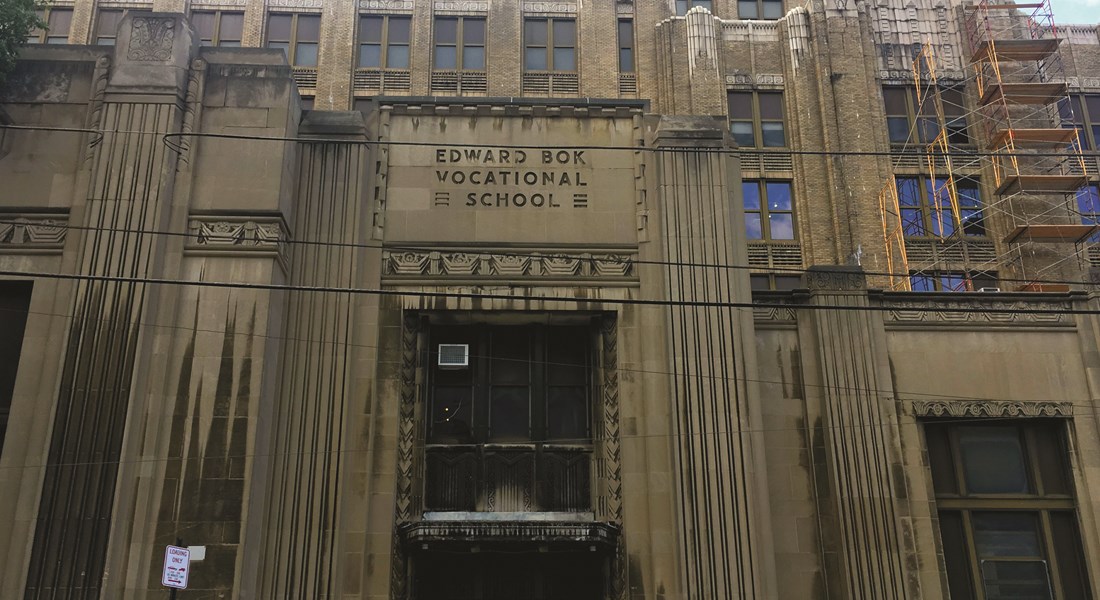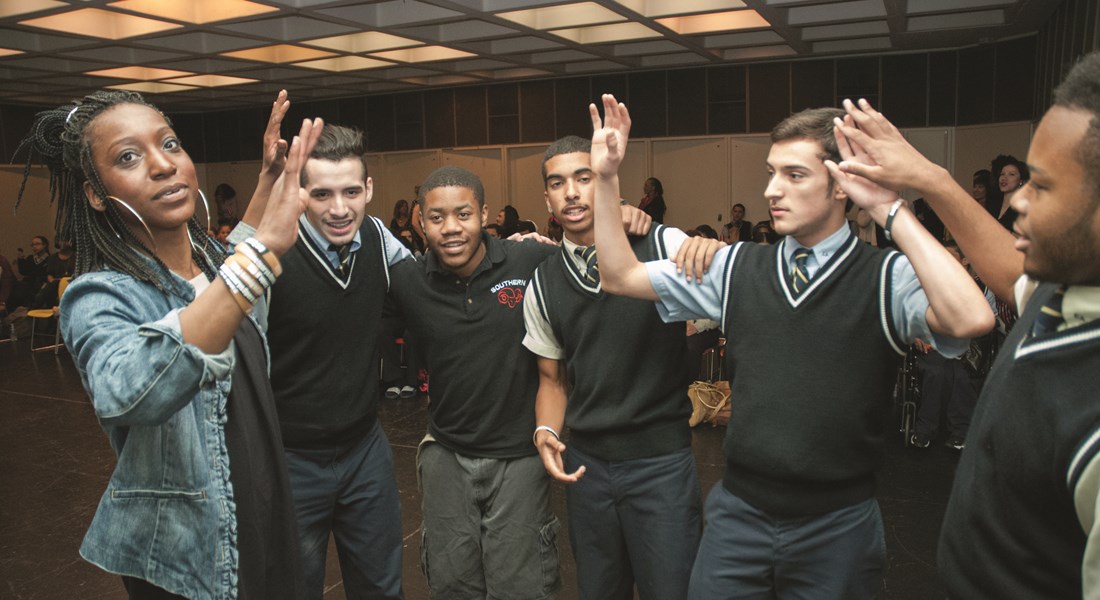Posted2 Sep 2017
- In
The Cost of Education: A Look Back at the Philadelphia School Closures of 2013
Students no longer roam the hallways of the historic Edward W. Bok Technical High School. Although the original infrastructure remains, there has been a change of residency. Classrooms are now being utilized as shared workspaces, while the school’s gym and auditorium are suitable to host events. Located in the East Passyunk Crossing neighborhood of South Philadelphia, for 75 years the former public school provided vocational programs from engineering to culinary arts. Today Bok’s hands-on, ready-to-work entrepreneurial spirit and facilities are preserved through a collective of small businesses, artists, craftsmen, chefs, and community organizers. The building was converted into a mixed-use development after being acquired through public auction in the aftermath of Bok’s closing in 2013, alongside 22 other K-12 schools as part of The School District of Philadelphia's “Facilities Master Plan.”

“They could’ve waited. They should’ve just stopped letting kids cycle in and allowed current students to graduate,” said Kynan Chambers, a former student at Bok who was transferred to South Philadelphia High School after the closing, and one of the many teens involved in Hip-H’opera. Hip-H’opera is the collaborative program between Opera Philadelphia and Art Sanctuary that provides workshops for students to channel self-expression through various art forms, which ultimately served as the inspirational platform for We Shall Not Be Moved. We meet the teens of We Shall Not Be Moved at the crossroads of real-life events that shape their journey. Like the characters who find themselves shut out of school and taking refuge at 6221 Osage Avenue, many Philadelphia teens have been affected by the homeless youth crisis and the 2013 school closures. These closures led to the displacement of thousands of students and educational staff, including a number of Hip-H’opera students who attended schools that would shut down after a closed vote. Mass school closings have become a recurring trend in large cities, including nearby areas like Washington, D.C., New York City, and Pittsburgh, in an effort to offset budget deficits and the increasing number of available seats. In an article for the Washington Post, independent education research organization Research for Action (RFA) detailed the overall short- to
We meet the teens of We Shall Not Be Moved at the crossroads of real-life events that shape their journey. Like the characters who find themselves shut out of school and taking refuge at 6221 Osage Avenue, many Philadelphia teens have been affected by the homeless youth crisis and the 2013 school closures. These closures led to the displacement of thousands of students and educational staff, including a number of Hip-H’opera students who attended schools that would shut down after a closed vote.
Mass school closings have become a recurring trend in large cities, including nearby areas like Washington, D.C., New York City, and Pittsburgh, in an effort to offset budget deficits and the increasing number of available seats. In an article for the Washington Post, independent education research organization Research for Action (RFA) detailed the overall short- to long-term impact of school closures based on statistics from cities that have taken similar actions as well as the proposed actions of the School Reform Commission. Their findings showed that, while there is a rather immediate amount of money saved by closings, from building maintenance to staff cuts, there are many implementation expenses, including costs associated with student relocation and moving, demolition and often the devaluation of closed buildings.
There was very little conversation surrounding the well-being of the students as an impact of the 2013 school closures. Originally set at 37 proposed schools to be closed by the School District of Philadelphia, parents, teachers, students, and community supporters voiced their concerns in the 21 community meetings leading up to the March 7, 2013 decision. On the day of the final hearing, Randi Weingarten, President of the American Federation of Teachers, as well as 18 other activists were arrested in protest. Many doubted the amount of savings the closings would return, but there was also the larger concern of whether the closings would improve the education of those transferred as stated by the School Reform Commission.
Research from RFA showed that the schools selected by the School Reform Commission for closure due to low performance had very similar performance standards to the receiving schools, meaning the transferring students wouldn’t necessarily be provided with a better education. Other concerns included longer walks and increased transportation time in unfamiliar neighborhoods.
“I feel like if I stayed at Bok I would’ve come out of high school with better opportunities and a higher education,” said Chambers. His transition from Bok to South Philadelphia High School created early challenges in the classroom.
“When they closed the schools, they moved the CTE (Career & Technical Education) Programs. It was difficult because the staff at South Philadelphia didn’t understand students in vocational programs, how we operate and the time and resources we need within the program. The resources didn’t transfer over. The rooms and workshop spaces weren’t equivalent. It went in a crazy direction because the program conflicted with South Philadelphia’s curriculum, making it difficult to learn.”
Teachers and staff were affected by the closings as well. Barbara Keating was a teacher at South Philadelphia during the transition, witnessing employees from both transferring and receiving schools experiencing layoffs.

“This stirred peoples’ lives into turmoil. South Philadelphia High School lost a lot of really great teachers because of seniority and right to follow,” said Keating. “Teachers at Bok had a right to follow their students over to South Philadelphia and we didn’t get as many of them as they thought, so that meant teachers who had less seniority from South Philadelphia lost their jobs. Teachers who had been at Bok for a really long time were really beholden to the building and the school and the programs and it’s jarring to have all of that ripped away from you.”
On the receiving end, South Philadelphia would have to prepare for more than 750 transfer students from Bok, doubling their enrollment. This was all in an effort to increase utilization within The School District of Philadelphia as they experienced a decline in enrollment due to factors such as the increase of students attending charter schools.
Nationwide school closures have disproportionately affected Black and Latino students, many of them residing in underserved communities. As a teacher for 14 years, Keating has come to terms that “a lot of these students come from places where childhood has been rushed for them,” noting that as many as “1 of 3 students have a challenge at home.” Closures recurrently affect minorities and the effects of shuttered schools can disrupt a student’s education and relationships with peers and teachers.
“All around everyone was upset and bothered because we had to go to a school that was completely different, not only the education but culturally,” said Chambers. “It’s like buying a brand-new car, investing into it and getting it recalled after you made an investment. It’s like ‘wow, we have to start all over again’ especially as a freshman, recently adjusting from middle school.”
The School District of Philadelphia has continued to seek solutions, developing multi-year plans to tackle budget cuts and the shift of student enrollment, possibly leading to more closures in the future.
“It’s tough, it’s really, really tough to be moved without your consent from one building to another,” said Keating.
While there are many factors involved in school closures, the cost at which these decisions are made undoubtedly have a major impact students, teachers, staff and parents for years to come.
Leave your comment below.

 Facebook
Facebook Twitter
Twitter More
More